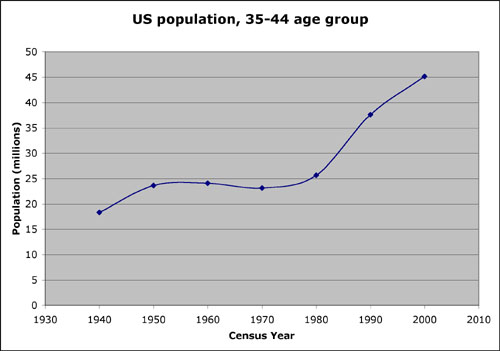
showing the median income for men and women in the 35-44 age group over the past few decades. The men's median income has stagnated or even reduced a little over the past 30 years. Given that the per capita GDP has increased substantially over time, this is taken to be a sign of increasing inequality, the increasing stress on the middle class, and the death of the American Dream.
For what it is worth, here is the size of the 35-44 age group over the past few decades, culled from the US government census site. (The documents are many megabytes, and I won't link to them from here).

The size of the 35-44 age group has grown from 25 million in 1980 to 45 million in 2000, a factor of 1.8. Of course, we need to extract the men, and from that the full-time working men, but unless things have gone greatly wrong, this should track the overall population quite closely. Without having done any calculation, I think there is room in this great expansion for many jobs below the (relatively constant) median and as many jobs above the median, so the average might have increased, the middle class overall may have increased. This can't be the only effect, all the concerns previously mentioned have to be taken seriously, but I think the demographics is making the situation seem worse than it actually is.
In any case, we don't have to look to overseas competition, the size of the labor pool in the US itself has increased so much; that would tend to hold down the median wage as well.
PS. Let me work out an example, for simplicity, using the full population figures (as though everyone worked).
Suppose in 1980, all jobs pay $40K, that the mean = median; all 25 million earn this.
Suppose by 2000, the 20 million additional jobs are 10 million at $30K and 10 million at $100K (and we keep the 25 million at $40K).
The median remains $40K.
The average is now $51.1K, 1.28 times the mean of 1980.
The total income for the 35-44 age group has gone up by a factor of 2.3.
Inequality has increased, but it is a judgment call whether we're better off/worse off than in 1980.
1 comment:
Good points.
Post a Comment